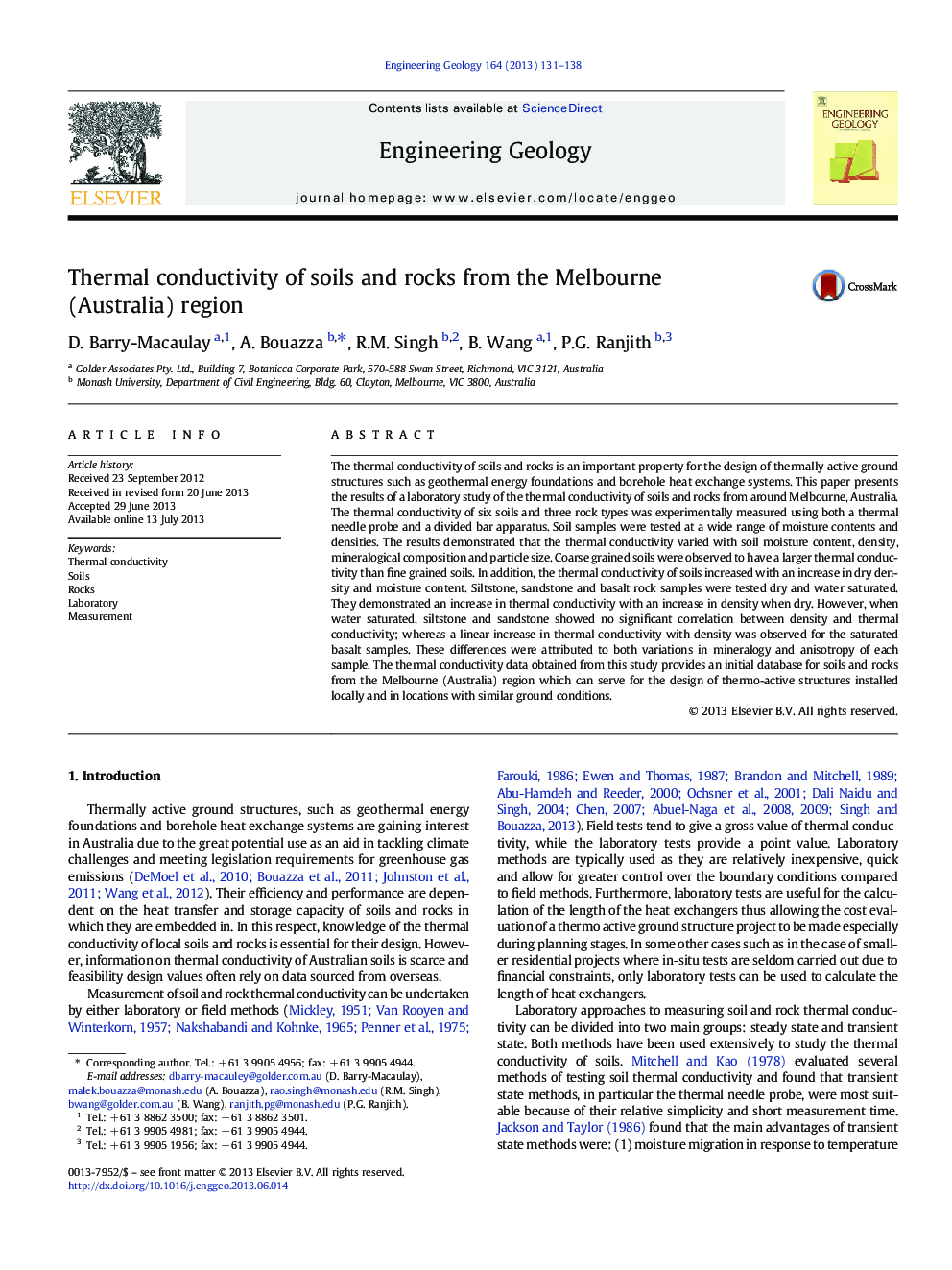| کد مقاله | کد نشریه | سال انتشار | مقاله انگلیسی | نسخه تمام متن |
|---|---|---|---|---|
| 6447916 | 1641820 | 2013 | 8 صفحه PDF | دانلود رایگان |
عنوان انگلیسی مقاله ISI
Thermal conductivity of soils and rocks from the Melbourne (Australia) region
ترجمه فارسی عنوان
هدایت حرارتی خاک و سنگ از منطقه ملبورن (استرالیا)
دانلود مقاله + سفارش ترجمه
دانلود مقاله ISI انگلیسی
رایگان برای ایرانیان
کلمات کلیدی
هدایت حرارتی، خاک، سنگها، آزمایشگاه، اندازه گیری،
ترجمه چکیده
هدایت حرارتی خاک ها و سنگ ها یک ویژگی مهم برای طراحی سازه های زمین گرمایی فعال مانند پایه های انرژی زمین گرمایی و سیستم های تبادل گرمای گمانه است. این مقاله نتایج آزمایشگاهی آزمایش هدایت حرارتی خاک و سنگ از اطراف ملبورن استرالیا را ارائه می دهد. هدایت حرارتی شش خاک و سه نوع سنگ به صورت آزمایشی با استفاده از هر دو پروب سوزن حرارتی و یک دستگاه نوار تقسیم شده اندازه گیری شد. نمونه های خاک در محدوده وسیعی از محتویات و تراکم های رطوبت آزمایش شدند. نتایج نشان داد که هدایت حرارتی با رطوبت خاک، تراکم، ترکیب کانی شناسی و اندازه ذرات متفاوت است. خاک های خاکستری مشاهده شده دارای هدایت حرارتی بیشتری نسبت به خاک های ریز دانه بودند. علاوه بر این، هدایت حرارتی خاک با افزایش تراکم خشک و رطوبت افزایش می یابد. نمونه های خاکستون، ماسه سنگ و سنگ بازالت، خشک و آب اشباع شدند. آنها افزایش هدایت حرارتی را با افزایش تراکم در هنگام خشک نشان دادند. با این حال، زمانی که آب اشباع شده، سیلتسون و ماسه سنگ، بین تراکم و هدایت حرارتی ارتباط معنی داری نداشتند؛ در حالی که افزایش خطی هدایت حرارتی با تراکم برای نمونه های اشباع بازالت مشاهده شد. این تفاوت ها به هر دوی این تغییرات در کانی شناسی و انیزوتروپیک هر نمونه مربوط می شود. داده های هدایت حرارتی حاصل از این مطالعه یک پایگاه داده اولیه برای خاک و سنگ از منطقه ملبورن (استرالیا) فراهم می کند که می تواند برای طراحی سازه های گرما فعال در محلی و در مکان هایی با شرایط زمین مشابه استفاده شود.
موضوعات مرتبط
مهندسی و علوم پایه
علوم زمین و سیارات
مهندسی ژئوتکنیک و زمین شناسی مهندسی
چکیده انگلیسی
The thermal conductivity of soils and rocks is an important property for the design of thermally active ground structures such as geothermal energy foundations and borehole heat exchange systems. This paper presents the results of a laboratory study of the thermal conductivity of soils and rocks from around Melbourne, Australia. The thermal conductivity of six soils and three rock types was experimentally measured using both a thermal needle probe and a divided bar apparatus. Soil samples were tested at a wide range of moisture contents and densities. The results demonstrated that the thermal conductivity varied with soil moisture content, density, mineralogical composition and particle size. Coarse grained soils were observed to have a larger thermal conductivity than fine grained soils. In addition, the thermal conductivity of soils increased with an increase in dry density and moisture content. Siltstone, sandstone and basalt rock samples were tested dry and water saturated. They demonstrated an increase in thermal conductivity with an increase in density when dry. However, when water saturated, siltstone and sandstone showed no significant correlation between density and thermal conductivity; whereas a linear increase in thermal conductivity with density was observed for the saturated basalt samples. These differences were attributed to both variations in mineralogy and anisotropy of each sample. The thermal conductivity data obtained from this study provides an initial database for soils and rocks from the Melbourne (Australia) region which can serve for the design of thermo-active structures installed locally and in locations with similar ground conditions.
ناشر
Database: Elsevier - ScienceDirect (ساینس دایرکت)
Journal: Engineering Geology - Volume 164, 17 September 2013, Pages 131-138
Journal: Engineering Geology - Volume 164, 17 September 2013, Pages 131-138
نویسندگان
D. Barry-Macaulay, A. Bouazza, R.M. Singh, B. Wang, P.G. Ranjith,
